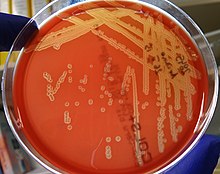Arcanobacterium haemolyticum
| Arcanobacterium haemolyticum | |
|---|---|
 |
|
| Arcanobacterium haemolyticum colonies on a blood agar plate: Beta-hemolysis is demonstrated with transmitted light. | |
| Scientific classification | |
| Domain: | Bacteria |
| Phylum: | Actinobacteria |
| Class: | Actinobacteria |
| Order: | Actinomycetales |
| Family: | Actinomycetaceae |
| Genus: | Arcanobacterium |
| Species: | A. haemolyticum |
| Binomial name | |
|
Arcanobacterium haemolyticum (ex Mac Lean et al., 1946) Collins et al., 1983 |
|
Arcanobacterium haemolyticum, formerly known as Corynebacterium hæmolyticum, is a species of bacteria classified as a gram-positive bacillus. It is catalase-negative, aerobic, beta-hemolytic, and not motile. It is part of the normal flora of the pharynx, but it may sometimes cause head and neck infections, pharyngitis, and sinusitis (Arcanobacterium haemolyticum infections).
It was first described by MacClean et al. in 1946 from US servicemen and peoples of the South Pacific suffering from sore throat. Due to its resemblance to another genus of bacteria, Corynebacterium, A. haemolyticum was initially classified as C. pyogenes subspecies hominus. It was known for several decades as Corynebacterium haemolyticum; controversies regarding classification were resolved in 1982 when a new genus, Arcanobacterium, was created by Collins et al. to reclassify Corynebacterium haemolyticum on the basis of its peptidoglycan, fatty acid, and DNA characteristics.
Since its initial description, the spectrum of diseases caused by A. haemolyticum has been expanded to include sepsis and osteomyelitis. Organisms are Gram-positive, facultative anaerobic, catalase-negative rods (but transition to the coccal shape occurs as the organism grows) with arrangements described as matchbox or Chinese letters arrangements. Growth is enhanced in blood and by carbon dioxide.
...
Wikipedia
